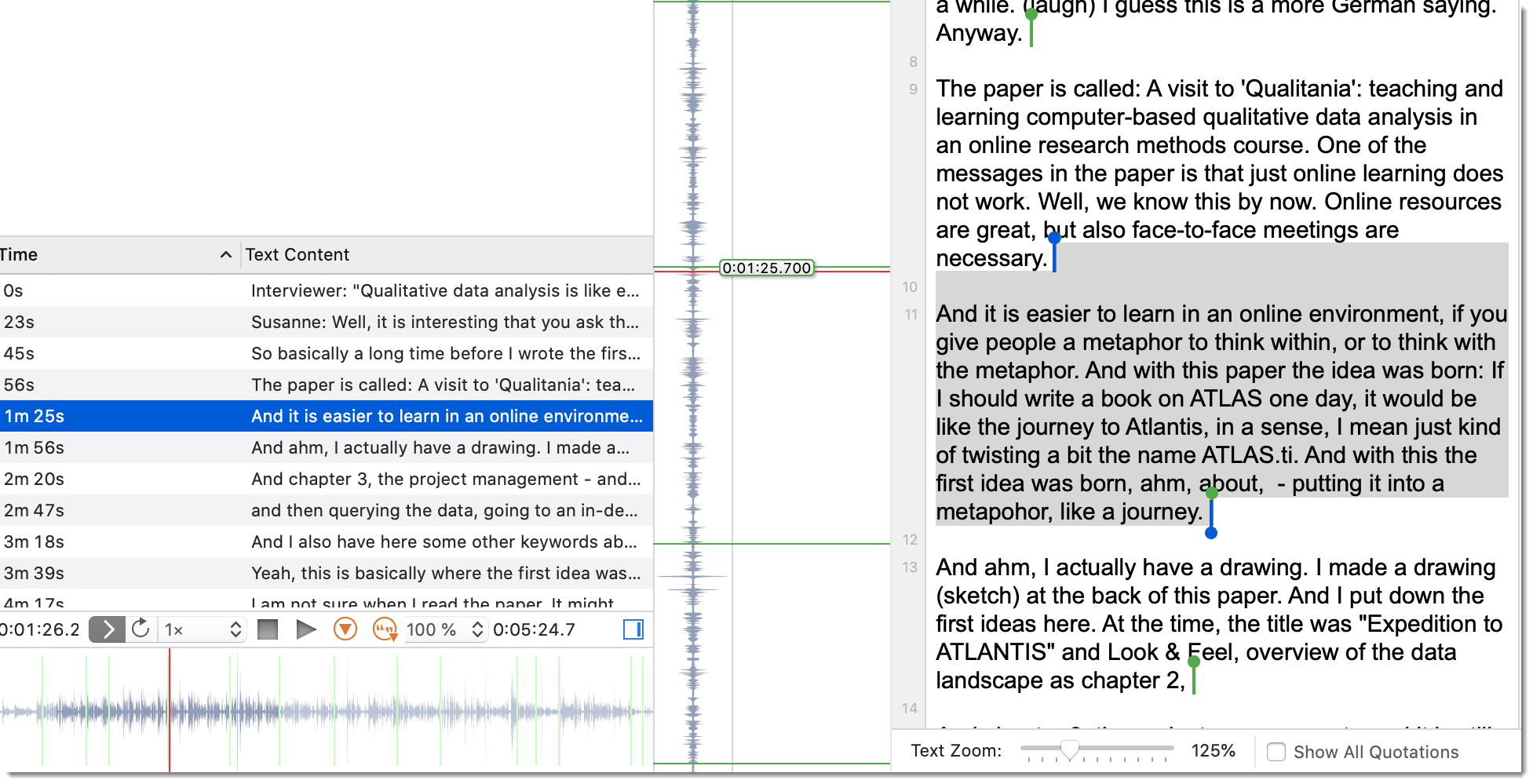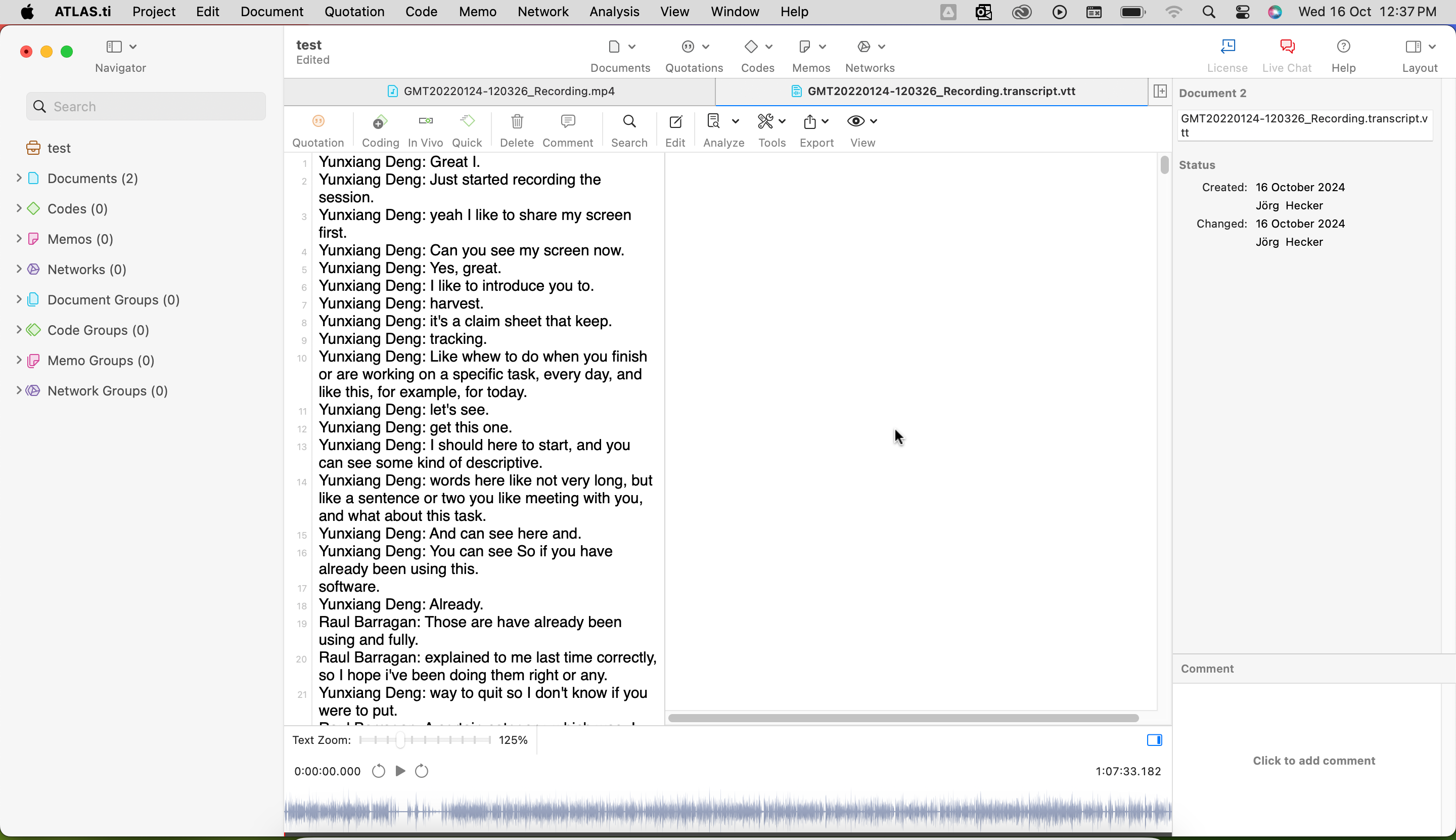- What is Interview Analysis?
- Advantages of Interviews in Research
- Disadvantages of Interviews in Research
- Ethical Considerations in Interviews
- Preparing a Research Interview
- Recruitment & Sampling for Research Interviews
- Interview Design
- How to Formulate Interview Questions
- Rapport in Interviews
- Social Desirability Bias
- Interviewer Effect
- Types of Research Interviews
- Face-to-Face Interviews
- Focus Group Interviews
- Email Interviews
- Telephone Interviews
- Stimulated Recall Interviews
- Interviews vs. Surveys
- Interviews vs Questionnaires
- Interviews and Interrogations
- How to Transcribe Interviews?
- Verbatim Transcription
- Clean Interview Transcriptions
- Manual Interview Transcription
- Automated Interview Transcription
- How to Annotate Research Interviews?
- Formatting and Anonymizing Interviews
- Analyzing Interviews
- Coding Interviews
- Reporting & Presenting Interview Findings
- How to cite "The Guide to Interview Analysis"
Clean Interview Transcriptions
Central to qualitative research is the transcription of audio or video recordings into a written form, a step that transforms raw data into a format amenable to detailed analysis. Among the various transcription styles, clean transcription has emerged as a preferred approach for many qualitative researchers. This article explores the concept of clean transcription, its significance in qualitative research, key characteristics, challenges, and solutions.

Introduction
Clean transcription is the process of converting recorded spoken language into a written format that is both accurate and optimized for analysis. Unlike verbatim transcription, which captures every utterance, including filler words, hesitations, and nonverbal cues, clean transcription focuses on conveying the essential content and meaning of the spoken words while omitting non-essential elements that may clutter the transcript and impede analysis.
A clean transcript provides a clear and organized textual dataset that researchers can easily navigate, code, and interpret. By eliminating filler words and non-essential elements, clean transcription allows for a more focused analysis of the core content, enabling the identification of themes, patterns, and insights with greater ease. Accurate transcripts ensure that the data remains faithful to the participants' perspectives and experiences. This fidelity is crucial for maintaining the credibility and trustworthiness of the research findings, as it minimizes the risk of misinterpretation or distortion of the original content.
Clean transcription reduces the time and effort required for researchers to sift through cumbersome verbatim transcripts. By presenting data in a streamlined format, it allows researchers to concentrate on analysis and interpretation rather than deciphering messy or cluttered transcripts. Maintaining confidentiality and anonymity is a cornerstone of ethical qualitative research. Clean transcription involves careful handling of sensitive information, ensuring that personal identifiers are appropriately managed and that the participants' privacy is upheld throughout the research process.
How to do a clean transcription
Performing a clean transcription involves transforming audio or video recordings into a clear, accurate, and analysis-ready written format.
Preparation
Begin by gathering and organizing all relevant audio or video recordings from interviews, focus groups, or other data collection methods. Ensuring the quality of these recordings is crucial; using high-quality recording equipment minimizes background noise and enhances speech clarity, which is vital for accurate transcription. Clearly label each file with identifiers such as the date, participant ID, and session number to maintain organization and facilitate easy retrieval.
Next, develop a set of transcription guidelines that outline your specific transcription style. These guidelines should cover aspects like speaker labelling conventions, formatting rules for paragraphs and punctuation, and criteria for excluding elements such as filler words ("um," "uh"), false starts, and non-verbal cues unless they are relevant to your research objectives. Distributing this guide to all transcribers ensures consistency across all transcriptions.
Selecting the right transcription tools is also a critical step. Decide whether to use manual transcription or leverage transcription software. Automated tools can expedite the process, while manual transcription software offers greater control and accuracy. For integrated transcription and analysis, qualitative data analysis software like ATLAS.ti can be particularly useful.
Transcription process
Start by thoroughly listening to the entire recording to familiarize yourself with the content, context, and any specific terminology that may be used. This initial listen helps identify challenging sections, such as areas with heavy accents, overlapping speech, or technical jargon, which may require special attention during transcription.
As you begin transcribing, focus on accurately capturing the spoken words while removing non-essential elements. This means omitting filler words, repeated phrases, and throat clearing unless they are significant for the analysis. Exclude non-verbal sounds like laughter or background noises unless they contribute to the research objectives. It's important to maintain the speaker’s tone and context by noting relevant pauses or emphases that enhance the meaning of the conversation.
Formatting the transcript is essential for readability and ease of analysis. Use clear speaker labels (e.g., Speaker A, Speaker B) to differentiate between speakers, and structure the transcript with logical paragraphing. Apply appropriate punctuation to convey the flow and intent of the speech accurately, and ensure grammatical correctness to maintain the integrity of the accurate transcripts while preserving the original meaning.

Quality assurance
After completing the initial transcription, conduct a thorough review and proofreading process. Compare the transcript with the original audio or video recordings to ensure accuracy and completeness. Correct any grammatical errors, misspellings, or inconsistencies in transcription style. It’s important to check for any omitted content and verify that all relevant spoken words are included without unnecessary clutter.
Maintaining consistency across all transcripts is another critical aspect of quality assurance. Ensure that the transcription guidelines are consistently applied by developing a comprehensive guide that outlines formatting rules and speaker labelling conventions. Regular training sessions and quality checks can further enhance consistency, especially when multiple transcribers are involved. This uniformity is crucial for the integrity of the data analysis process.
Finalization
Once the transcript has been reviewed and refined, proceed to anonymize sensitive information to protect participants' privacy. Remove or replace personal identifiers such as names and locations with pseudonyms or codes as specified in the transcription guidelines. This step is essential for adhering to ethical standards in qualitative research.
Save the finalized transcripts in a standardized format (e.g., .docx, .pdf) to ensure compatibility with qualitative data analysis software. Organize the transcripts systematically, using consistent naming conventions that correspond to the original audio or video recordings. Securely store the transcripts to protect sensitive information, employ encrypted storage solutions if necessary, and create backups to prevent data loss and ensure accessibility for future analysis.
Analyzing clean transcripts
ATLAS.ti offers robust features for working with transcriptions, whether they are textual, audio, or video-based. You can easily import transcripts in widely used formats and integrate transcribed data into your qualitative research.
For those working with multimedia files like audio or video, ATLAS.ti Desktop allows users to associate text-based transcripts with their media files. This feature ensures a smooth workflow when conducting analysis that involves spoken data, such as interviews or focus group recordings.
Time-stamping
Time-stamped transcripts help streamline the analysis process, enabling users to jump directly to relevant sections of their recordings. This functionality is especially helpful in research that involves detailed and time-sensitive qualitative data analysis.

Code and analyze transcripts
Once your transcript is uploaded to any of the ATLAS.ti versions, you can take advantage of its powerful coding tools to thoroughly analyze your data. These tools allow you to mark sections of text and apply relevant codes, which aids in organizing and making sense of large amounts of qualitative data. Whether you’re working with interview transcripts, focus group sessions, or any other form of textual data, the ability to easily code and retrieve information greatly enhances the efficiency of your analysis.
Managing and working with multimedia transcripts
In addition to supporting transcription files, ATLAS.ti Desktop also offers synchronized scrolling between the text transcript and its linked audio or video file. This means that as you scroll through your transcript, the corresponding section of the media will play, allowing for a more in-depth and precise analysis. This feature is particularly valuable for researchers who need to cross-reference spoken content with its transcription, providing an accurate and fluid analysis experience.

Challenges and solutions in clean transcriptions
Despite its numerous advantages, clean transcription presents several challenges that researchers must navigate to ensure successful implementation.
One significant challenge is handling accents and dialects. Accents and dialects can complicate the transcription process, potentially leading to misinterpretations or inaccuracies. To address this, it is essential to employ transcribers who are familiar with the specific accents and dialects of the participants. Additionally, providing clear guidelines and contextual information can aid transcribers in accurately capturing the spoken content, thereby minimizing errors related to linguistic variations.
Another common obstacle is dealing with poor audio quality. Background noise, overlapping speech, and low-quality recordings can severely hinder the transcription process, resulting in incomplete or inaccurate transcripts. To mitigate these issues, researchers should invest in high-quality recording equipment and ensure optimal recording conditions during data collection. When faced with poor audio quality, utilizing noise-cancellation features in transcription software and replaying difficult sections can help improve accuracy. These strategies enhance the clarity of the recordings, making the transcription process more efficient and reliable.
The time-consuming nature of transcription is also a notable challenge, particularly when transcribing lengthy recordings manually. Manual transcription can be labor-intensive and time-consuming, potentially delaying the research timeline. To overcome this, researchers can utilize automated transcription tools to expedite the process. These tools can be supplemented by manual review and editing to ensure accuracy. Additionally, delegating transcription tasks to trained assistants or specialized transcription services can alleviate the time burden, allowing researchers to focus more on data analysis and interpretation.
Maintaining consistency across transcripts is another challenge, especially when multiple transcribers are involved. Ensuring uniformity in transcription style and formatting is crucial for the integrity of the data analysis. To achieve this, researchers should develop and adhere to a comprehensive transcription guide that outlines formatting rules, speaker labelling conventions, and criteria for excluding or including specific elements. Regular training sessions and quality checks can further enhance consistency, ensuring that all transcripts adhere to the established standards and facilitating smoother comparative analysis.
Preserving context and nuance while performing clean transcription requires a delicate balance. Clean transcription involves removing non-essential elements without losing the contextual nuances that are crucial for analysis. To maintain this balance, it is important to train transcribers to recognize and retain contextually significant elements, such as pauses or emphasis, that contribute to the overall meaning of the conversation. Incorporating brief notations or annotations can help preserve subtle nuances without cluttering the transcript, ensuring that the depth and richness of the data are maintained for accurate and meaningful analysis.
Conclusion
Clean transcription is an indispensable component of qualitative research, bridging the gap between data collection and meaningful analysis. By transforming spoken language from audio or video recordings into a clear, accurate, and organized written format, clean transcription enhances the integrity and efficiency of the research process. It facilitates comprehensive analysis, supports data fidelity, and upholds ethical standards, making it a preferred method for many qualitative researchers.
Implementing clean transcription effectively requires a combination of methodological rigor, adherence to best practices, and the strategic use of technology. By understanding its key characteristics, recognizing its importance, and addressing the inherent challenges, researchers can leverage clean transcription to unlock the full potential of their qualitative data.




